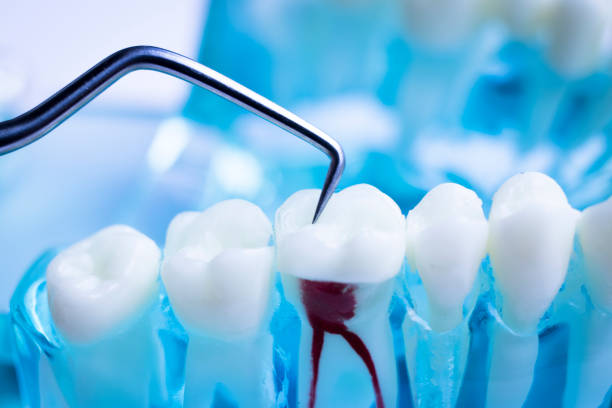- Cedre Shopping Centre | Dubai Healthcare City Center
- drdoaa@theperfectioninsmile.com
ROOT CANAL | TREATMENT


DESCRIPTION OF A ROOT CANAL
• Root canal treatment to remove tooth infection and pain.
Root Canal Treatment, also known as Endodontic Treatment is the treatment of the root canals of a tooth. The aim of root canal treatment is to remove infection and/or pain and to fill the root canals to prevent further infection.
• Where is the root canal?
The root canal is a thin channel that exists in the roots of the teeth. Normally these channels are filled with nerves and blood vessels that supply the tooth. The root canal system may become compromised (infected and/or painful) and need root canal treatment.
• What causes a tooth infection and the need for root canal treatment?
The most common cause of a tooth infection is tooth decay, tooth trauma, or a poorly fitting restoration such as a filling or a crown.
These conditions can cause bacteria to enter the pulp of the tooth. The blood vessels and nerves reside in the pulp of the tooth. They become inflamed and begin to die. The dead cells and bacteria progress to form an infection.
Frequently Asked Questions
Root canal symptoms often come in two waves. When the pulp becomes infected, early signs that you might need endodontic treatment include toothache, sensitive teeth to hot and cold foods, and pain when eating and drinking. When the infected pulp dies, these symptoms may temporarily subside – but don’t be tempted to put off seeing your dentist! When the infection spreads to the root canal, those early symptoms come back – this time accompanied by pain and swelling to the face and gums, and pus around the infected tooth, which will often appear dark in colour. In this scenario, contact us immediately for an emergency dentist appointment.
Root canal treatment is carried out under local anaesthetic and is usually a straightforward procedure, rather like getting a filling. Once the tooth is completely numb, the dentist will use a series of tiny instruments to open up the tooth and extract the infected pulp. The remaining space is cleaned and shaped, ready for filling with a rubbery substance called gutta-percha. A temporary filling is usually placed on top – the permanent restoration would be carried out in a separate appointment.
You can carry on as normal once the anaesthetic has worn off, though the full healing period will take around a week – just be careful with what you eat, how you chew and maintain an excellent oral hygiene routine.
WhatsApp us

